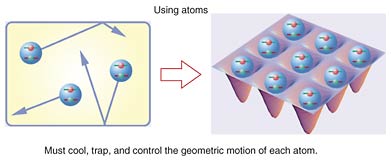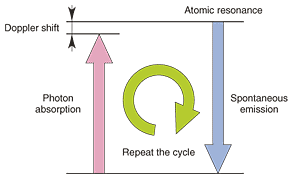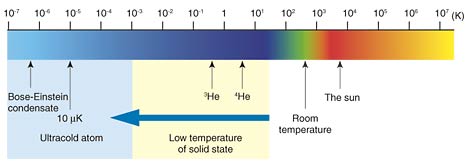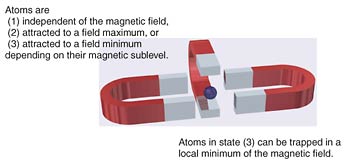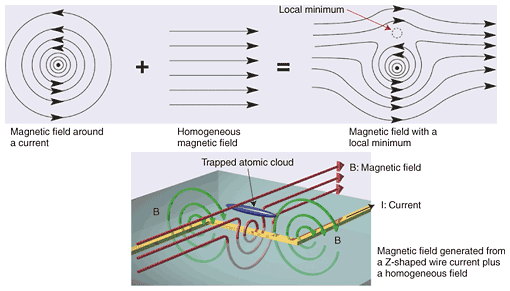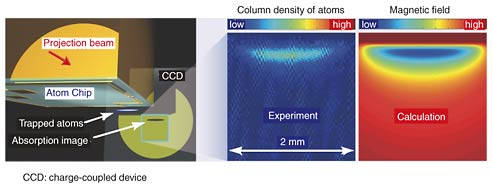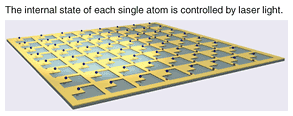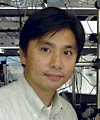 |
|||||||
|
|
|||||||
|
Selected Papers: Quantum Computing Vol. 6, No. 1, pp. 53–57, Jan. 2008. https://doi.org/10.53829/ntr200801sp7 Making a Quantum Computer Using Neutral AtomsAbstractNeutral atoms have several good features that make them suitable as building blocks for a quantum computer. A key technology for utilizing these good features is geometrical control of each single atom. Using a persistent supercurrent atom chip, which NTT has achieved for the first time, we are trying to overcome the difficulties in controlling single atoms and are aiming to construct a quantum computer using neutral atoms.
1. Approaches to making a quantum computerQuantum computers are expected to solve specific problems very much faster than their conventional counterparts as a result of their quantum parallelism. To achieve such an impressive outcome, the central processing unit of a quantum computer must satisfy at least two requirements. First, a sufficient number of quantum bits (qubits) for recording quantum information must be prepared. Second, the quantum states of the qubits must be controlled via flexible interactions. One promising candidate for achieving such qubits and interactions is semiconductor low-dimensional quantum structures or superconducting circuits for controlling magnetic flux. NTT has been devoting a huge amount of effort to creating these. This research is strongly dependent on microfabrication techniques, so we call it a top-down approach. On the other hand, another research project has been going on in the background behind the major ones. This is a bottom-up approach using single atoms on a chip. This minor approach with atoms has gradually been maturing and has recently succeeded in achieving a specific result that had never been demonstrated before. In this paper, I introduce the atom chip project, which is a hot topic that was recently reported in the mass media. 2. Neutral atomsAs is well known, neutral atoms have complex structures with surrounding outer-shell electrons and a central nucleus, which is constructed from protons and neutrons. The quantum mechanical properties of such atoms are understood via the absorption and emission of photons with specific frequencies. The geometrical scale of a single atom is about 0.1 nm for the diameter to the outer-shell electrons; this is about two orders smaller than the achievable limit of state-of-the-art nanotechnology. In general, thermal atoms at room temperature move at a speed of about 1000 km/h, which is almost the same speed as an aeroplane or a bullet from a hand gun. Because atoms are so small and fast, we need to cool, trap, and control the geometric motion of each single atom in order to achieve quantum gate operations with atoms (Fig. 1). Until about 20 years ago, this was far beyond our practical reach. However, laser cooling, the topic of the Nobel Prize in Physics in 1997, can solve the problem and pave the way to realizing the dream of quantum computation using atoms.
3. Laser coolingThe well-known Doppler effect causes the frequency of light to seem higher when the light source is approaching the receiver. This mechanism lets us cheat atoms approaching a laser source. Atoms flying toward the light source experience a light frequency that is slightly higher and absorb photons with a frequency slightly lower than the resonance frequency. Having absorbed photons and entered an excited state, these atoms spontaneously emit photons with the resonant frequency on average. Since the energy of a photon is proportional to its frequency, the atoms lose kinetic energy through this cycle of lower-energy absorption and higher-energy emission. As a result, they are decelerated or cooled down (Fig. 2). After about ten thousand repetitions of this cooling cycle in less than a second, the temperature of the atoms becomes very low and the velocity of the atoms reaches less than 1 km/h, i.e., an atom flying like a bullet is quickly decelerated to under the walking speed of a human being. That is rapid cooling from room temperature to 10 µK, one ten-millionth of its original temperature (Fig. 3). This is two orders smaller than the lowest temperature achievable with state-of-the-art solid-state cooling.
4. Magnetic trapAtoms with a small amount of energy, equivalent to a temperature of less than 1 mK, can be trapped with a relatively weak potential field, e.g., a magnetic field potential. In general, depending on their magnetic sublevels, atoms are (1) independent of a magnetic field, (2) attracted to a magnetic field maximum or (3) attracted to a magnetic field minimum. Atoms attracted to a magnetic field minimum (state (3)) can be trapped in the manner illustrated in Fig. 4.
5. Atom chipThe magnetic field generated by a permanent magnet is static, but the field generated by a flowing current can be controlled dynamically. A local minimum of the magnetic field potential generated from a flowing current can be achieved with a Z-shaped wire on a chip substrate plus a homogeneous magnetic field, as illustrated in Fig. 5. This technique is called the Atom Chip. It is a research topic that has been growing rapidly in the last five years. It is useful in practice for trapping a large number of atoms with a relatively small current and has recently been applied to cutting-edge research in atomic physics. However, the Atom Chip technique has difficulty trapping a single atom. To make a single-atom trap, we need a strong trapping confinement or a short atom-current distance. However, in the vicinity of the surface of the current-carrying wire, electrical and thermal noise introduces an unwanted transition of atoms to the untrapped state (state (1) or (2)), which shortens the trapping lifetime. A persistent supercurrent atom chip is a new idea that is expected to overcome the short-lifetime problem occurring at small atom-surface distances. It does not need any wire connection to a power supply for driving current and it is theoretically noise free. For this reason, it is strongly expected to yield a single-atom trap on an atom chip.
6. Persistent supercurrent atom chipThe concept of our experiment on trapping rubidium atoms with a magnetic field generated by a persistent supercurrent on a chip is shown in Fig. 6. The number of atoms was 500,000, the atom-surface distance was 300 µm, and the temperature of the atomic cloud was 200 µK. The persistent current running on the chip was estimated to be 2.5 A by comparing the shape and position of the trapped atomic cloud and the calculated magnetic potential. This atom trapping technique on a noise-free device should lead to single-atom trapping and manipulation by reducing the atom-surface distance to the order of 1 µm. Moreover, in future, with the aid of atom-photon interactions, single-atom traps on an atom chip will be used as building blocks for a quantum computer.
7. Quantum computation with atomsOne of the specific features of using atoms as a resource for a quantum computer is scalability. We can prepare the largest possible number of atoms with exactly the same properties. Atoms are natural resources and we do not have to manufacture them. Another advantage of using single atoms is that we can make an atom chip without any special techniques. Even though the geometric size of an atom is of the order of 0.1 nm, a 1-µm-diameter wire is sufficient for controlling single atoms. For example, with a two-dimensional atomic array with a 10-µm atom-atom distance, a 1-mm2 area can hold tens of thousands of atoms as independent qubits (Fig. 7). The 10-µm separation is sufficient to enable laser light to be focused on a single atom without interacting with the other qubits, and a 1-mm square is small enough for all of the atoms to be in a single cavity mode of an optical resonator that can control all qubits with a single laser light.
The other good point about using single atoms is stability. Although we must cool their temperature to below 1 mK to trap and control the geometric motion of the atoms, which makes the experiment very hard, the influence from environmental disturbance is really small for neutral atoms, i.e., the quantum information in an atom is preserved for a long period. The maximum time that quantum information in a solid-state qubit can be kept is of the order of 1 µs, but that of an atomic qubit is expected to be more than a million times as long (~1 s). 8. ProspectsEven though the bottom-up approach with atoms for constructing a quantum computer is still at the stage of preparing qubits, single atoms have several advantages for achieving quantum gate operations and they are promising candidates for constructing quantum computers. The drawbacks of the atomic quantum computer include the difficulty of the laser cooling technique and the small number of researchers who are sufficiently skilled at atomic manipulation. Fortunately, NTT is the only private company with researchers who are experts in laser cooling, and it has succeeded in making a Bose-Einstein condensate, which has the lowest temperature in the universe. References
|
|||||||








